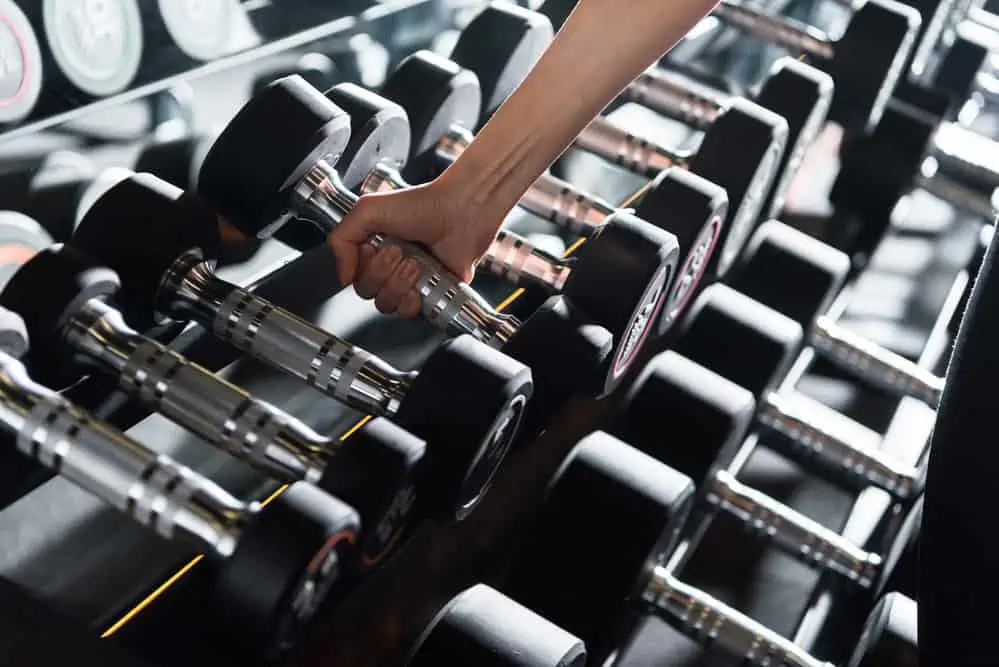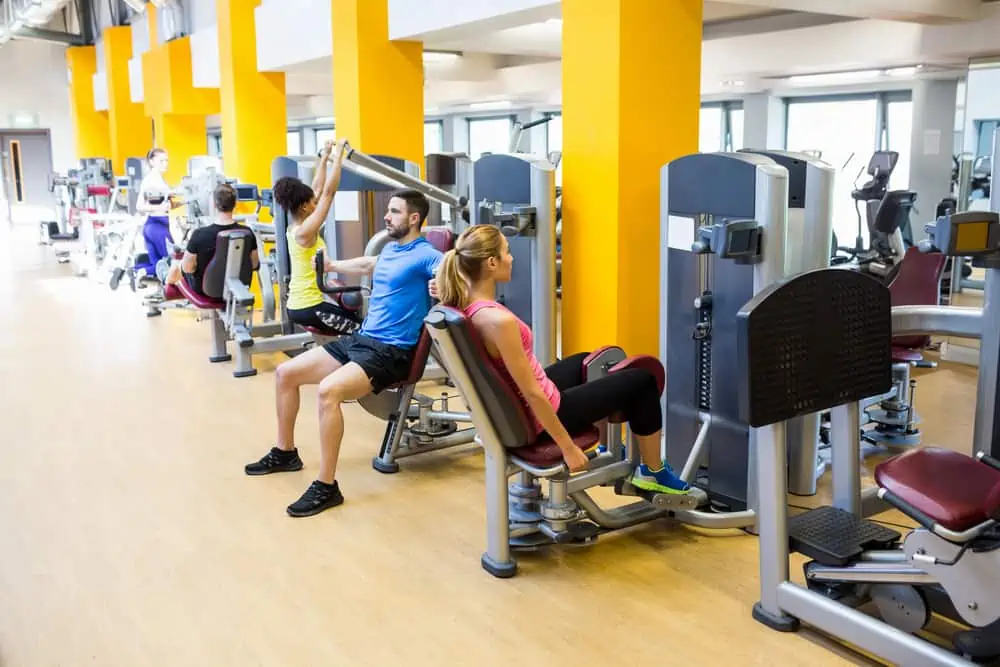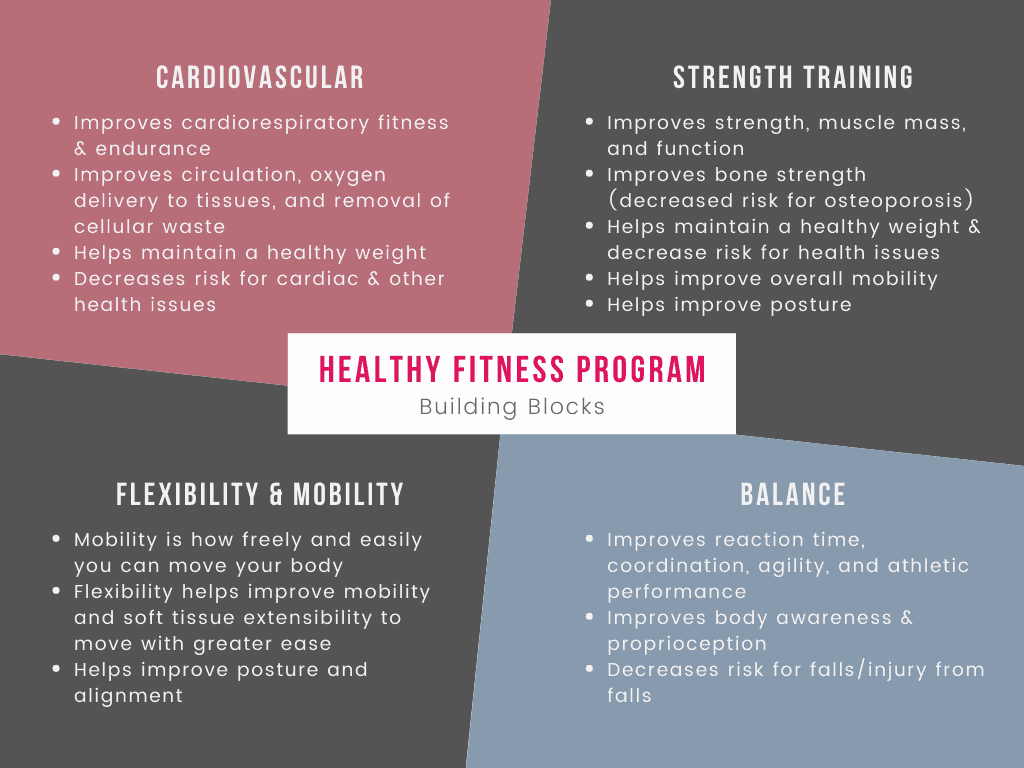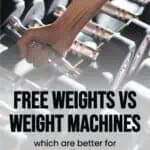This post may contain affiliate links. If you click through a link and make a purchase, I may receive a commission at no additional cost to you. As an Amazon Associate, I earn from qualifying purchases. Read the full disclosure here.
With so many strength training options available, it’s no surprise that people fall into analysis paralysis when choosing which weights to use.
Free weights vs. machines and which one is “better” is a very common question.
Both free weights and machines offer unique individual benefits, and there are other considerations (such as your fitness level and your personal goals) to determine which activities are best for you.
This article will break down the specifics to help you confidently structure your fitness program.
Disclaimer: This content is for educational purposes and is not medical advice. Read the full disclaimer.
Free weights
The most classic example of free weights is dumbbells.
But technically, anything not attached to another piece of equipment can be considered a free weight. Barbells, kettlebells, weighted balls, sandbags, etc., are also considered free weights.
Free weights can appear more approachable than other types of workout equipment.
Because of this, you’ll also find many people misusing them.

Free weights are very versatile for performing isolated or combo strength movements. (An example of an isolated movement is a bicep curl. An example of a combo movement is a lunge with a bicep curl.)
You can use free weights to perform upper body, lower body, and core exercises for a total body workout.
Weighted balls, sandbags, or kettlebells help perform more dynamic combo activities.
Each strength movement has prime mover muscles (which are the main muscle groups you’re trying to target) and other muscles function to stabilize you.
You can get more of a stabilization benefit when using free weights because you need to work harder to control the movements (versus lying down or sitting on a machine).
Free weight pros
- Free weight training allows you to move in comfortable ranges not dictated by a fixed path
- They offer many weight options and provide total body workout options
- Able to perform isolation or compound exercises
- More benefit for working associated stabilizing muscles during each movement
- They can easily be incorporated into group fitness classes and accommodate many fitness levels, with the lowest weights starting around 1-2 pounds
- Free weights are reasonably inexpensive and don’t take up much space, making them a great choice for home gym equipment
Free weight cons
Free weights are precisely that, free. They are not attached to any other tracks or equipment that might help keep you aligned.
Proper technique is crucial when working with free weights because there is a lot of room for error.
Slow and controlled movements are encouraged to build strength and avoid injury. Free weights may not be the best option for those with poor movement awareness.
A spotter may be needed for heavier weights to avoid serious injury.
Common mistakes with free weights
- Using the wrong weight for the exercise (either too light or too heavy)
- Swinging the weight or using momentum to accomplish the exercise
- Poor form or movement patterns
Side note about kettlebells
Kettlebells are a popular form of free weights but aren’t exactly a 1:1 swap.
Kettlebells offer some unique strengthening and many people like them because they look cool.
Because of the handle on top and center of mass outside of your grip, you can use them for more dynamic movements than your standard dumbbells.
Research is mixed; however, some studies suggest kettlebell workouts provide additional cardio, endurance, and muscular power as benefits over more traditional weight training methods.
Performing kettlebell movements requires more stabilization and momentum, which is usually something to avoid with strength training.
While there is some overlap with dumbbell exercises as far as what movements you can do, kettlebell exercises can be very different. You should never pick up a kettlebell and start swinging it around without proper instruction.
If you’re interested in learning how to use kettlebells, seek proper instruction from someone explicitly trained in kettlebells to avoid starring in a #gymfails YouTube video.
Weight machines
Most gyms have various weight machines of multiple sizes, shapes, and brands.
Machine weights isolate specific muscle groups. Examples of common types of weight machines are lat pulldown, seated row, hamstring curl, leg press, and chest press, to name a few.
There are many weight machines, but each is somewhat of a one-trick pony compared to other strength training equipment. For example, all you can do at a chest press machine is a chest press. On the other hand, free weights allow you to do many different exercises with the same set of weights.
Exercise machines may slightly vary in appearance, depending on the manufacturer. However, if you know how to use one chest press machine, you should easily be able to figure out another.
Many have directions on the machine detailing which muscle groups are targeted and how to use the equipment, making them appealing to beginners.
Weights are either adjusted by pulling/placing a pin in the weight stack or manually loading plates.
You can add extra small weights to accommodate more options if you’re not ready to bump up to the next available weight on the stack.

Weight machine pros
- Assist with proper alignment
- Allow for heavier weight that may not be manageable with free weights
- Isolate specific muscle groups
- Help you get a sense of how an exercise should feel
Weight machines can assist with proper alignment, making them easier for beginners or those who have difficulty monitoring their form.
They can also help you learn how a movement should feel as you gain awareness and sense of movement with new exercises.
Machines can accommodate heavier weight options and isolate specific muscle groups.
Weight machine cons
- The path of the weight machine dictates your range of motion, which may or may not be comfortable for your body
- Not ideal set up if you’re very short or very tall
- Not able to perform compound strength exercises
- Lack of variety in smaller facilities
- Some machines don’t offer functional movements
While they might seem more straightforward, you can still hurt yourself.
These machines take up a lot of space, and there may be limited muscle group options if it’s a small facility. You can get stuck only working a few areas if you’re only using machines.
With machine training, alignment may not always be optimal. You will need to know how to adjust your height/available range of motion. If you’re very short or tall, you may struggle to find a comfortable range of motion on some machines, and movements may feel unnatural or uncomfortable.
Sitting down and isolating one muscle group at a time cannot keep your heart rate up and incorporate more stabilizing into your exercise.
Some weight machines don’t offer the most functional movements, for example, the leg extension machine.
A functional strength exercise mimics a motion performed in everyday life. An example of this is step-ups.
So back to the knee extension machine. Does it provide some strengthening to the quads? Some.
Do you ever make this motion in your everyday life? No. Therefore, it doesn’t directly translate into functional movement.
I’m not saying don’t use this machine, but don’t make it the only quad strengthening exercise you do. It’s fine as a piece of an overall program.
If you’re looking to limit your time to exercises that provide the most benefit for your time, then a more practical option is a leg press or bodyweight squat.
Does this provide strengthening to the quads? Yes, as well as other lower body muscle groups simultaneously.
Do you ever make this motion in life? Yes, like every time you get up from a chair or bend down to pick something up.
Common mistakes with weight machines
- Not setting up the machine properly
- Not choosing the correct weight
- Moving too quickly or using momentum
Free weights vs. machines in research
There have been a few studies that looked at the effects of free weights vs. machines.
Schwanbeck SR et al. looked at the effects of training with free weights versus machines on muscle mass, strength, free testosterone, and free cortisol levels over an 8 week period.
The study concluded that training sessions using free weights demonstrated greater increases in free testosterone in men; however, training with free weights or machines resulted in similar increases in muscle mass and strength.
Aerenhouts D et al. is another recent study looking at the effects of free weights vs. machines plus a combination of both and its effects on anthropometrics, strength, and functional ability in novice adult males.
This study found similar gains in muscularity, strength, and functional ability regardless of the equipment being used or switching between machines and free weights. For this population, any choice of resistance training equipment has similar benefits.
The takeaway here is that for the average person, the most important part is that you’re doing some type of resistance training that’s challenging you.

Benefits of strength training
Strengthening exercises belong in everyone’s fitness routine and offer benefits not found with other forms of exercise.
- Improve muscle mass, strength, and function
- Helps with weight loss and weight management, improving body composition
- Decreased risk for osteoporosis and aids in maintaining healthy bones
- Decreases the overall risk for health issues
Read more about the building blocks of a healthy fitness plan here.
Wrapping up
Free weights vs. machines – what’s the final verdict?
Incorporating both types of strength equipment into your routine can help you build a well-rounded strength program.
The proper ratio of free weights to machines will be different for everyone, and you should choose based on your fitness level and individual goals.
You can also work with a personal trainer to establish a proper resistance training program that’s appropriate for you.
Check out these two articles about TRX for strengthening and other resistance training options to add to your routine.
References
Aerenhouts D, D’Hondt E. Using Machines or Free Weights for Resistance Training in Novice Males? A Randomized Parallel Trial. Int J Environ Res Public Health. 2020;17(21):7848. Published 2020 Oct 26. doi:10.3390/ijerph17217848
Schwanbeck, Shane R.1; Cornish, Stephen M.2; Barss, Trevor3,4,5; Chilibeck, Philip D.1 Effects of Training With Free Weights Versus Machines on Muscle Mass, Strength, Free Testosterone, and Free Cortisol Levels, Journal of Strength and Conditioning Research: July 2020 – Volume 34 – Issue 7 – p 1851-1859
doi: 10.1519/JSC.0000000000003349






